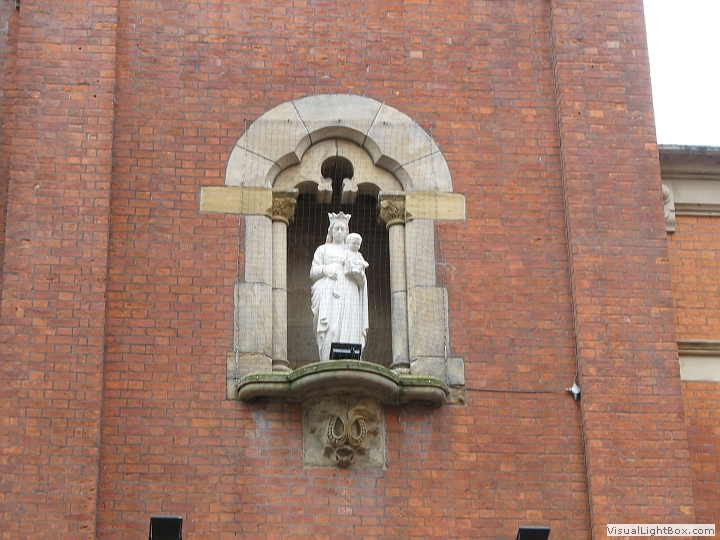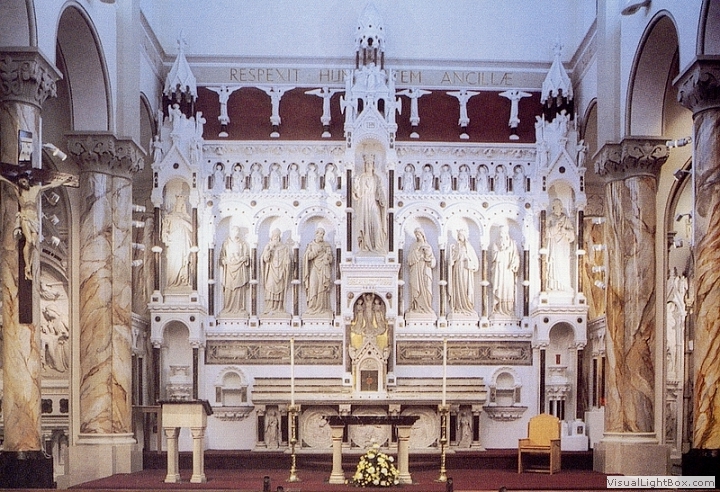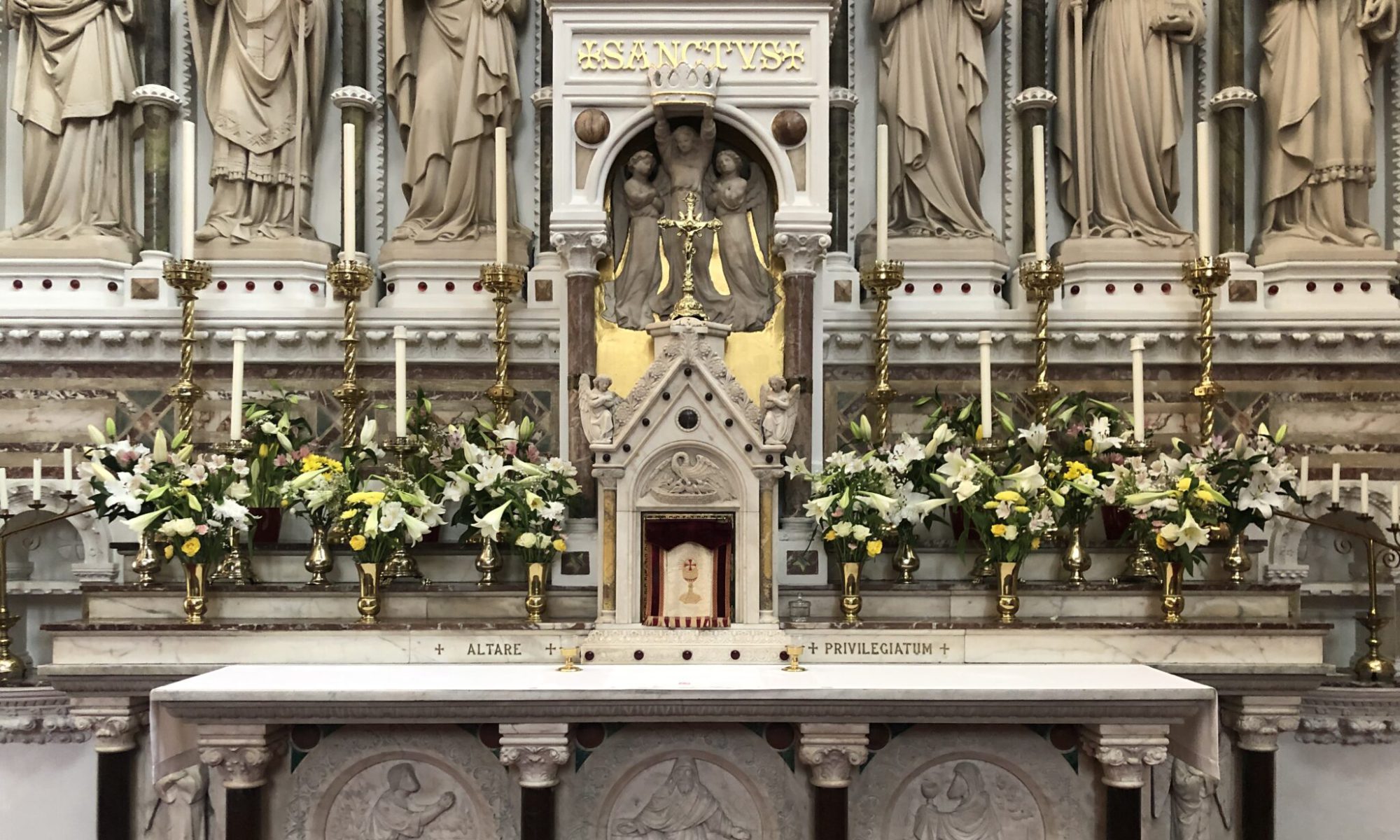A Short History of St. Mary’s
In 1422, King Henry V granted permission for the collegiation of the parish church of Manchester, dedicated to St. Mary the Virgin of Manchester. Papal confirmation was given by Martin V in 1426, and the document of confirmation may still be seen in the Vatican archives.
During the reign of Edward VI, the college was dissolved, but then refounded briefly in the reign of Mary I. The Ancient parish church of Manchester eventually came under Anglican control and is now known as the Manchester Cathedral. It still carries the medieval dedication to to St. Mary, St. George and St Denys.
Rook street chapel
In 1774, a small house/chapel was erected, which stood at the northern end of what is now Fountain Street and West Mosley Street. It was named the Rook Street Chapel and dedicated to St. Chad. It served the scattered Catholic population of areas in Manchester, Salford, Bolton Rochdale, Trafford, Stockport, Glossop and Macclesfield, which numbered probably no more than 600.
The chapel was taken over by Father Roland Broomhead in 1778, beginning a 42 year service of ministry to the people of Manchester. The chapel was completely destroyed by fire in 1846 and no trace of it remains. A new parish of St. Chad’s was then founded away from the city, as it was then, in Cheetham Hill.
The building and dedication of the “Hidden Gem”

Father Broomhead purchased a plot of land in Mulberry street for the erection of a new church, dedicated to Our Lady’s Assumption into Heaven. The official opening of the church was on 30th November 1794. Rev Arthur J. Dobb, an Anglican historian commented in his “History of the Diocese of Manchester” published in 1978:
“The Roman Catholic Church sought to tackle Manchester’s deepest troubled area which lay between Deansgate and Albert Square. A church was built in 1794 in Mulberry Street on a site crowded in by intensive poor-quality housing on land which had so recently been open meadow and grazing pasture.”
“St. Mary’s much rebuilt, still stands of the same plot of land, now surrounded by the edifices of sophisticated materialism, which is probably more spiritually barren ground than the moral vileness of the 18th century.”
Along with the church, on the same plot of land, the presbytery stands next to it, and has been continuously occupied since 1794.
The collapse of the roof and subsequent rebuilding
In 1833 Father Henry Gillow decided to re-roof and redecorate the church. However, the work was not overseen by a master builder and was therefore suspect. On 8th August 1835 most of the roof collapsed, causing significant interior damage. An outbreak of plague in Manchester around the time, and Father Gillow’s death from Typhus in 1837, made the search for a new site for St. Mary’s difficult. In the end, a decision was made to rebuild the church on the same site. The architect chosen was Matthew Ellison Hadfield. In the years that followed, the city took shape around it – the Town Hall, Albert Square, the John Rylands Library, the Central Library and so on.
The interior of the church

Father John Newton took charge of St. Mary’s in 1869. He engaged a sculptor, a Mr Lane of Preston, to design and implement all the carving that still graces the interior of the church.
The High altar is surmounted by a reredos of Caen stone, on top of which are the figures of Angels. The life size figures of the reredos are (from left to right): Our Lady, St. Stephen, St. Patrick, St. Peter, above the tabernacle Our Lord, with his sacred heart, St John the apostle, St. Hilda of Whitby, St. Augustine of Canterbury and St. Joseph.
On the left of the high altar, is a side altar of marble and Caen stone dominated by the life-size Pieta. Around the top are the figures of angels.
The shrine of Our Lady of Manchester is on the right of the high altar. The shrine also comprises the scene from Our Lord’s nativity on the left and the presentation in the Temple of Our Lady as a little girl by her parents, St. Joachim and St. Anne. In a wall to the right, is a stained glass window representing Our Lady and her prayer, the Magnificat.
Further developments
In 1872, Herbert Vaughan became the second Catholic Bishop of Salford. Bishop Vaughan also founded Manchester’s most famous Catholic school, St. Bede’s College. He also was the first to use the term “Hidden Gem” to apply to the church, commenting that:
“No matter on what side of the church you look,
you behold a hidden gem”
In the early 1990’s, the church was completely restored, rewired, decorated and repaired outside and within, as was the ancient presbytery.
When Granada Television showed Sunday Mass from St. Mary’s over the national network on 24th July 1988, the immensely favourable response from all over the British Isles by letter and telephone, from Catholic and non-Catholic was beyond all expectation.
Bishop Kelly, in 1990, described the visit of the Papal Pro-Nuncio Archbishop Barbarito as “an endorsement of the Hidden Gem’s great service to the spiritual wellbeing of the whole city”.
In 1994, St. Mary’s celebrated its bicentenary and continues to be a spiritual oasis, for Catholic and non-Catholic alike, in the heart of a busy and thriving modern city.
